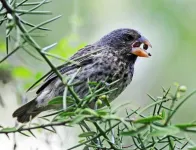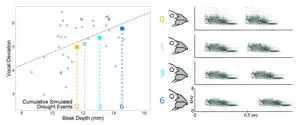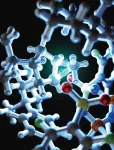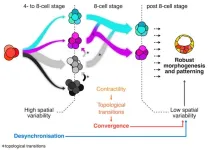(Press-News.org)
Embargoed: Not for Release Until 2:00 pm U.S. Eastern Time Thursday, 10 October 2024
October 10, 2024
AMHERST, Mass. – They say that hindsight is 20/20, and though the theory of ecological speciation — which holds that new species emerge in response to ecological changes — seems to hold in retrospect, it has been difficult to demonstrate experimentally, until now. In research recently published in Science, biologists from the University of Massachusetts Amherst have identified a key connection between ecology and speciation in Darwin’s finches, famous residents of the Galápagos Islands, Ecuador. Prior work on these birds had established that birds’ beaks adapt to changing ecological environments, and that beak changes affect how the birds sing. But, until this paper, no one has yet been able to experimentally show that such changes drive the emergence of new species. The innovative key to this discovery? The ghosts of future finches.
Research recently published in Science by biologists from UMass has identified a connection between ecology and speciation in Darwin’s finches, famous residents of the Galápagos Islands, Ecuador. Prior work on these birds had established that birds’ beaks adapt to changing ecological environments, and that beak changes impact how the birds sing. The new study shows that beak-driven changes to song themselves can impact species recognition, and thus drive the separation of species.
“I started working with these birds 25 years ago,” says Jeffrey Podos, professor of biology at UMass Amherst and the paper’s senior author. “In my very first publication on the finches, back in 2001, I showed that changes in the beaks of Darwin’s finches leads to changes in the songs they sing, and I speculated that, because Darwin’s finches use songs to attract mates, then song changes related to beak evolution could perhaps catalyze ecological speciation.”
But, at the time, Podos had no smoking-gun experimental evidence with which to prove his hypothesis that environmentally driven changes to beak shapes were driving the emergence of new finch species. Part of the difficulty is that speciation is an historical process, which makes it tricky to document. Being able to watch it unfold as it happens would be like catching lightning in a bottle. As a workaround, Podos devised an experimental study that built on simulations, and he had some helpful leads to work with.
He knew, for instance, that beaks can either evolve powerfully to crush hard seeds or they can remain more delicate thereby enabling the faster movements necessary for more elaborate singing. “It takes serious motor performance to sing an intricate song, like that of the swamp sparrow,” says Podos, “and a big, powerful beak is just too clunky to manage the movements required.”
Thanks to decades’ worth of quantitative research that the wider biology community has conducted on the exact changes that the beaks of Darwin’s finches undergo due to different environmental changes, Podos realized that he could model how beaks would change into the future. In this case, he chose drought as the ecological driver, which tends to select for thicker-beaked finches. And he also knew that he could both predict, and then simulate, the songs of the finches as they would change through successive future episodes of drought.
“Essentially, we engineered the calls of future finches,” says Podos.
In general, the thicker the beak, the slower the songs and the narrower the bandwidth of the frequencies. Each subsequent drought event is predicted to render beaks that are increasingly thicker, which further should further slow the rate and decrease the bandwidths of the songs.
Finally, Podos and his team returned to the specific population of Darwin’s medium ground finches and played them the calls of the future finches.
“We found that there were no changes in the finches’ responses to our modified calls even when the simulated songs had changed by the equivalent of three drought events,” says Katie M. Schroeder, the paper’s co-author who participated in this research during her doctoral training under Podos at UMass Amherst. “But by six drought events, the had changed so much that the finches barely responded at all.”
These findings suggest that, because of the links between beaks and song, an entirely new species of Darwin’s medium ground finches could evolve in response to six major Galápagos droughts.
“Our research is not a conceptual revolution,” says Podos, “but it is an empirical, experimental confirmation of ecological speciation and its plausibility.”
This research was supported by the Charles Darwin Research Station and Galápagos National Park Service and the U.S. National Science Foundation.
Science has prepared a media kit, which is available at https://www.eurekalert.org/press/scipak/.
Additional images and audio recordings are available at this Google Drive link.
Contacts: Jeffrey Podos, jpodos@cns.umass.edu
Daegan Miller, drmiller@umass.edu
END
An organic catalyst offers chemists precise control over a vital step in activating hydrocarbons.
Researchers at Hokkaido University in Japan have made a significant breakthrough in organic chemistry by developing a novel method to activate alkanes, which are compounds that play a crucial role in the chemical industry. The new technique, published in Science, makes it easier to convert these building blocks into valuable compounds, offering advances in the production of medicines and cutting-edge materials.
Alkanes are a primary component of fossil fuels and are also vital building blocks in the production ...
Galápagos finches use their beaks to crush seeds and sing songs, so what happens to their musical trills when their beaks change to respond to new menus available under drought? Jeffrey Podos and Katie Schroeder found that the song might not remain the same after six cumulative future drought events that would likely reshape the finch beak. The projected changes in male mating songs could be so significant that they provide a pathway for ecological speciation, the researchers suggest. The researchers tested this idea by digitally modifying ...
Newly discovered microscopic mucus tails – trailing from particles of marine snow particles – slow these particles’ descent into the deep ocean, research finds. This doubles the particles’ residence time in the ocean's upper layers and significantly alters estimates of how much carbon is sequestered in the deep sea. The oceans serve as a vast reservoir and critical sink for atmospheric carbon dioxide. A key process driving carbon sequestration in the ocean is the biological pump, where photosynthetic activity ...
Europe is facing a seed dispersal “crisis,” due to extinction threats and population changes among the animals that do the seed dispersing, according to a new synthesis by Sara Beatriz Mendes and colleagues. Their literature review of animal and plant dispersal pairs helped them reconstruct the first European-wide seed dispersal network. Seed dispersal by animals is a critical part of maintaining healthy ecosystems, especially in fragmented environments like those found throughout Europe. Lack of seed dispersal to connect populations could prevent declining plant populations from ...
Researchers have documented a shift in plant species ranges toward the poles or higher latitudes in the face of climate warming, but Pieter Sanczuk and colleagues now reveal another unexpected pattern of range shift. For decades, understory plants in European temperate forests have been on the move westward, spurred by differences in nitrogen deposition rates. Westward species distribution shifts were 2.6 times more likely than northward ones, according to the researchers, who also noted that forest canopy changes played a role in this shift as well. The findings suggest that factors beyond climate change, such as atmospheric pollution, are also an important part of redistributing biodiversity. ...
Pasadena, CA—The world’s freshwater lakes are freezing over for shorter periods of time due to climate change. This shift has major implications for human safety, as well as water quality, biodiversity, and global nutrient cycles, according to a new review from an international team of researchers led by Carnegie Science’s Stephanie Hampton.
Undertaken by scientists based in the United States, Canada, and Sweden, this analysis represents a major call-to-action for wintertime freshwater ecology research. It is published in Science.
The world has millions of freshwater lakes, most of which freeze during the winter. The team’s rigorous review indicates ...
Pipetting liquids into tiny test tubes, analyzing huge datasets, poring over research publications—all these tasks are part of being a scientist. But breaking this routine is essential. Time away from the usual work environment can spark creative ideas. Lab retreats, for instance, offer a great setting where researchers can engage with other peers, often leading to new collaborations.
The latter was true for Bernat Corominas-Murtra and Edouard Hannezo from the Institute of Science and Technology Austria (ISTA). Fascinated by a dataset showcased during a poster session at a collaborative ...
There is variability in when and how cells divide during the development of embryos. While researchers traditionally believed this variability was an obstacle that needed to be regulated, the Hiiragi group now found that it actually promotes healthy development. The results, published in Science on 11 October 2024, encourage other scientists to see the potential of variability and could have significant impact on assisted reproductive technology.
An embryo consists of cells. These cells divide to make new cells, allowing the embryo to grow. The cells experience variability in how and when they divide and in how they interact with each other. Scientists ...
New Stanford-led research unveils a hidden factor that could change our understanding of how oceans mitigate climate change. The study, published Oct. 11 in Science, reveals never-before seen mucus “parachutes” produced by microscopic marine organisms that significantly slow their sinking, putting the brakes on a process crucial for removing carbon dioxide from the atmosphere. The surprising discovery implies that previous estimates of the ocean’s carbon sequestration potential may have been overestimated, but also paves the way toward improving climate models and informing ...
New research reveals nitrogen pollution, and to a lesser extent climate change, unexpectedly as the key driver behind surprising westward shifts in the distribution of plants.
A recent study has uncovered that many European forest plant species are moving towards the west due to high nitrogen deposition levels, defying the common belief that climate change is the primary cause of species moving northward. This finding reshapes our understanding of how environmental factors, and in particular nitrogen pollution, influence biodiversity.
While it is widely assumed that rising temperatures are pushing many species toward cooler, northern areas, this research shows that westward ...







